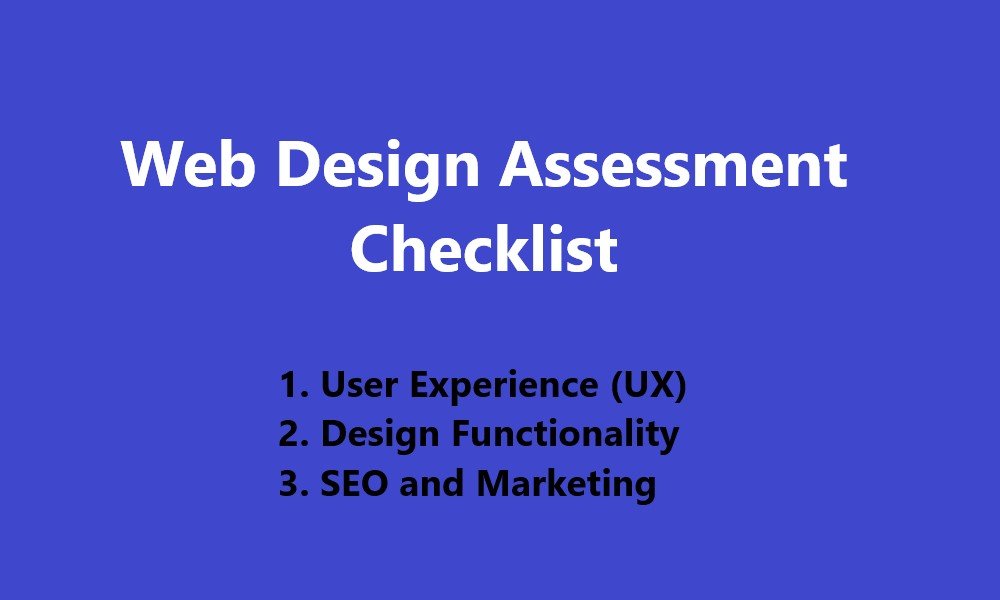Looking for web design assessment checklist?
Creating the perfect website to draw traffic, attention, feedback is an overwhelming task. You can’t just finish and launch the newly developed site for public response. Instead, it’s a steadfast tradition to asses the web design prior to its final launch.
The checklist can be explained in various ways since all the facts are more or less interconnected here. You can’t ignore all the obvious features to determine the potential acceptance. The must-look checklist includes three fundamental points for design.

Table of Contents
ToggleUser Experience (UX)
It’s the feeling a user, customer, or viewer experiences while going through a website product, content, and service. It ranges from the direct interaction of your site with audiences to the entire process of completing the actions or tasks.
The perception of every user ultimately paves the way to success or failure in web design. Your users will go through your offers to evaluate the usability, differentiated values, and pleasure. And UX happens to be the determining website structure to accommodate such features.
A high-level UX adds effective value to deliver a relevant experience for your clients. It directly prompts the viewers to find, check, return to your website. In turn, the customers will tend to become loyal to your services, information, and/or products.
Therefore, UX considers the following:
- Provoked feelings and triggered emotions.
- Represented context from user perspectives.
- Evolution of UX with time to impact users.
Meantime, the checklist for UX design related to the assessment of a developed website concerns:
- Attractive Visual: Keeping every element on each webpage organized can instantly hit the user’s mind. It further helps the audiences to conduct or take actions based on the designed progress.
- Relevant Content: It covers the most crucial part where the users will easily find what they need. Also, keeping the focus on this part is rather important while incorporating objective content.
- Faster Loading: It’s the silent metric to determine the overall efficiency of your website. Nobody likes to wait for clicks, requiring the website to become and remain faster to load every page.
- Scannable Content: It allows the user to go through your site in the proposed or developed order. Alternatively, viewers can choose to read highlighted titles alongside their preferred info.
- Responsiveness: Developing a website for desktop or laptop use can no longer cut it. You must ensure that each electronic device to support internet browsing can access the site comfortably.
Assessing the UX design for your website through these parameters will lay the foundation to launch and keep going towards success.
Design Functionality
Precise functionality of the designed website involves many major as well as minor factors. It’s possible to categorize the must-consider fundamentals with many embedded concerns.
- Cross-Browser Compatibility: The site must work equally well on all available or leading browsers. Chrome, Safari, Firefox, Edge – must be prioritized above all others. Always focus on the coding, features, animations, and interactions. You can get assistance from tools like BrowserStacks, SauceLabs, LambaTest here.
- Navigational Components: Check every button, menu, and dropdown while looking into an intuitive interface. It also concerns how easily a user, regardless of limitations on abilities, can reach and read the content. Don’t forget all the external as well as internal links since you can’t expect a good impression with faulty clicks.
- Accessibility Standards: Maintaining and confirming all the web elements according to WCAG (Web Content Accessibility Guidelines) standards. Specifically, look into the alternative texts, keyboard navigation, and color contrast. Everything must remain equally pleasing and perfectly understandable for all kinds of audiences.
- Tracking and Analytics: Proper setting and retrieval of crucial viewer data through a reliable analytics tool is utterly important. So, feel free to place a tracking system or code on individual webpage without reservation. Don’t miss out on the setup of conversion tracking for e-commerce websites for a better assessment of data.
- Confronting Errors: every mistake conducted by the user shouldn’t lead to error messages or web pages. Handling grave errors and minor errors separately can certainly boost user engagement. You should come up with something constructive on minor errors. Remain helpful information and/or guidance to correct the mistakes.
- Visual Contents: All visuals like images, videos, GIFs must come compressed, optimized, and clear. And it also concerns the minimization of unnecessary spaces and characters from the code. Loading speed or efficiency of this content is highly important. Keep removing unnecessary scripts to retain desired performance there.
User testing on every feature prior to final launching or release has been a key part of website design assessment. Compromised functionality can’t or won’t help your website shine in the competition.
SEO and Marketing
You’ll have to start by reaching out to the audience to convince the viewers to look into your website. And motivating the customers to make purchases sums up the motto of online marketing strategy. It comprises of specific number of actions, not necessarily confined to limited boundaries.
- Search Engine Optimization (SEO): It’s the ultimate method to pump up your presence and reach amidst other competitors. Bring up all the standard as well as local keywords in the writing without pushing hard. The same goes for meta descriptions, titles/headings, and meta tags on individual articles.
- Social Media Marketing: Integrate and check whether all the sharing buttons for different social media platforms work perfectly. You should even remain active on leading social media pages or groups to provide updates. Integrations like content embedment and feed must remain activated.
- Promoting Brands or Content: Develop catchy, impressive, and meaningful content to keep up with the required usability. Adopting a catchphrase or instantly hitting a motto, logo, campaign should aid every webpage. Hiring professionals is the best way to accomplish the perfect momentum here.
A well-organized system can give you a better chance of appearing first on search results (SERPs). It should help your website trend well on online platforms satisfactorily to get loyal users.
Wrapping Up
Assessment of a website’s design involves many checking and rechecking to get, fix, test the entire structure. And don’t let the simple list of evaluations fool you, since many embedded concerns are lurking on every corner. The web design is only considered successful when all the facts coincide altogether.
Contact Tectera a web design company in Toronto to design a website.




